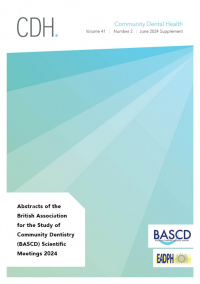September 2010
Plaque, caries level and oral hygiene habits in young patients receiving orthodontic treatment
Abstract
Caries Research Unit UNICA, Dental Faculty, Universidad El Bosque, Bogotá, Colombia; 2Department of Cariology and Endodontics, Dental Faculty, University of Copenhagen, Copenhagen, Denmark Objective: To assess plaque, caries, and oral hygiene habits amongst patients receiving fixed-orthodontic treatment at the Dental-Clinic, Universidad-El-Bosque, Bogotá, Colombia. Basic research design: Test-group: 74 12-29-year-olds receiving fixed-orthodontic treatment; reference-group: 63 12-29-year-olds before they started the orthodontic treatment. Visual examinations (one examiner) recorded the following: Ortho-plaque-Index (OPI) expressed per patient as good, fair and poor-oral-hygiene. Caries was scored with the modified-ICDAS-II criteria as: 0-sound; 1B/1W-brown/white-opacity-after-air-drying; 2B/2W-brown/white-opacity-without-air-drying; 3-microcavity; 4-underlyingshadow; 5/6-distinct/extensive-cavity. Filled/missing surfaces due-to-caries and caries-lesions on buccal surfaces at three sites around the brackets were recorded. A 7-item self-administered oral-hygiene habits’ questionnaire was used. Results: Chi-square test revealed that the oral-hygiene level was significantly better in the reference group compared to the test group (p<0.05). The traditional mean DMF-S was 6.7±6.3 in the test- and 6.2±5.9 in the reference-group (p>0.05). When adding modified-ICDAS-II lesions scores 1-4, the figure increased to 23.6±9.4 in the test- and to 13.6±10.3 in the reference-group (p<0.001). A total of 96% had ≥1 white-opacity in the test group versus 56% in the reference group (P<0.001). In the test-group the buccal-surfaces accounted for most white-opacities and close to 1/3 of these lesions on the upper-anterior teeth were located around the brackets. The questionnaire disclosed that 58% in the test- vs. 44% in the reference-group did not accept having dental caries lesions during the orthodontic treatment. Conclusions: The results showed a high prevalence of white-opacities related to orthodontic appliances and indicate the need to implement preventive programmes at the dental clinic. Key words: Buccal surfaces, dental caries, ICDAS-II criteria, oral hygiene, orthodontics.




